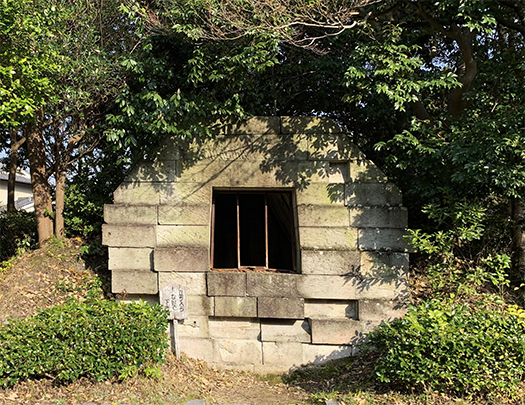

さて今回の飛鳥宮探訪では橿原考古博物館の展示に非常に教えられた。
やはり考古の視点というか、物証に裏付けられた探究は
明示的でロジカルな世界での理解を教えてくれて非常に楽しい。
これからも時間を見つけて再訪できたらと念願しています。
その帰り際、玄関と向かい合うように植栽で囲まれた一角があり
よく説明を読んだら、なんと古墳時代のブロック建築だと知れた(!)。
わが家は北海道の正調・外断熱ブロックなので、はるかなご先祖様とのご対面(笑)。
ちなみに「石槨〜せっかく」という固有名称は
〜石で築いて作った棺を納める室。自然石を積みあげたり切石を組み合わせた。
屍体をおさめる古墳内部の施設。石室(せきしつ)。〜ということ。
この石槨は明日香村近郊の奈良県高取町佐田にある
束明神古墳(つかみょうじんこふん)にあるものを実大復元させた。
切石積みの石槨は飛鳥時代の建築構造のなかでも特異な存在ということ。
その構築技術をあきらかにするために同質の素材の凝灰岩で制作した。
ただし天井と入口部分は推定復元による、とされていた。
復元に当たっては昭和59年当時の石工技術者の尽力で実現したと記述されている。
以下は、Wikiの説明要旨部分。
〜丘陵の尾根の斜面を大きく削って整地し、その中央に直径20m・高さ4mの
円墳状の墳丘を版築技法で築く。凝灰岩を段状に積み上げて南側に開口する
横口式石槨で内部は長さ3.12m・幅2.06m・高さ2.5m前後。
(盗掘で破損しており正確な計測は困難)となっている。床面には二重、
壁面には5段に石材が積み重ねられており床には漆喰が塗られている。
棺・副葬品がほとんどないが若干の被葬者の歯牙と木棺の破片とみられる
漆膜片などがみられ他に釘が50本以上みられる。
また幕末に同古墳が草壁皇子の陵墓に比定されるという話が伝わり、
陵墓指定のために土地を奪われることを恐れた地元の人々が
意図的に破壊したとする伝承がある。実際に被葬者の歯牙から推定される
死亡年齢や古墳の様式より、草壁皇子の陵墓をここから260mほど北にある比定地の
眞弓丘陵(岡宮天皇陵)ではなくこことする説もある。〜
いろいろな事情が垣間見えて興味深い。
盗掘被害はある程度やむを得ないけれど、史跡指定されると
その土地所有者はさまざまに制約を受けて土地利用が不可能になるので
実利を優先させて破壊に至るというのも理解できる部分がある。
その時代に合わせて生きている人間の実利と史的価値の乖離。
しかしそれにしても、いわゆる「組石造」という建築であり
現代ではブロックの場合、中空部を造作してそこに鉄筋補強するけれど、
そういう技術の無い時代に、しかも地震多発の日本の国土特性の中で
どのように生き延びてきたのか、この「建築」に頭を垂れておりました。
English version⬇
Kofun period “block tomb” stone burial mound, Asuka, Nara.
Asuka still retains masonry building techniques such as stone stages that seem to have originated in the Stone Age. As a modern block housing people, we respect it much more. Nara, Asuka
During my visit to Asuka Palace, I was very much impressed by the exhibits at the Archaeological Museum of Kashihara.
I enjoyed the archaeological point of view, or rather, the exploration backed by physical evidence.
I am very much enjoying the clear and logical understanding of the world of archaeology.
I hope to find time to revisit the museum in the future.
On my way back to the house, I found a corner surrounded by plants facing the entrance.
After reading the description carefully, I learned that it was a block building from the Kofun period (!). I was so happy to find out that it was a block building from the Kofun period (!).
Our house is built in Hokkaido with regular block construction and external insulation, so we met our ancestors from far away (laugh).
By the way, the proper name of “stone burial chamber” is
〜A chamber for a coffin made of stone. It was made by piling up natural stones or combining hewn stones.
A facility inside a burial mound to hold a corpse. A stone chamber. 〜A stone burial chamber.
This stone burial chamber is located in Sada, Takatori Town, Nara Prefecture, near Asuka Village.
This stone burial chamber is a full-scale reconstruction of the one in the Sokuakijin burial mound in Sada, Takatori-machi, Nara Prefecture, near Asuka Village.
The hewn stone burial chamber is unique among the architectural structures of the Asuka period.
In order to clarify the construction technique, the burial chamber was made of tuff, which is a homogeneous material.
However, the ceiling and the entrance part are based on a presumptive restoration.
The restoration was realized in 1984, thanks to the efforts of the masonry engineers of the time, according to the report.
〜The slope of the ridge of the hill was cut and leveled, and a 20-meter-diameter, 4-meter-high circular burial mound was built in the center of the slope using a printing technique.
A circular mound was built in the center of the hillside using the printing technique. The mound is made of tuff piled up in steps and opened on the south side.
The interior is 3.12m long, 2.06m wide and 2.5m high.
(The interior is 3.12m long, 2.06m wide, and about 2.5m high (exact measurement is difficult due to the damage caused by theft). The floor is covered with double
The walls are made of five layers of stone, and the floor is covered with plaster.
There are almost no coffins or burial accessories, but there are some teeth of the deceased and a piece of lacqueous film, which appears to be a fragment of a wooden coffin.
There are few coffins and burial accessories, but there are some teeth of the deceased and a piece of lacquer film, which is thought to be a fragment of a wooden coffin.
At the end of the Edo period, there was a story that the burial mound was compared to the mausoleum of Prince Kusakabe, and the land was taken away to designate it as a mausoleum.
It is believed that the tomb was intentionally destroyed by local people who feared that their land would be taken away to designate the tomb as a mausoleum.
The tomb is believed to have been intentionally destroyed by local people who feared that their land would be taken away to designate the tomb as a mausoleum. The actual age of death and the style of the burial mound are more important than the age of death and the style of the burial mound.
Based on the age of death and the style of the burial mound, the mausoleum of Emperor Kusakabe was designated as a specific site about 260 m north of here.
The age of death and the style of the burial mound suggest that Emperor Kusakabe’s mausoleum was not located at Mayumi-oka-ryo (Okamiya Emperor’s Mausoleum), which is 260m north of here. ~~
It is interesting to get a glimpse of the various circumstances.
Although damage from theft is unavoidable to some extent, if the site is designated as a historic site, the landowner will be subject to various restrictions that make it impossible to use the land.
However, if the land is designated as a historic site, the landowner is subject to various restrictions that make it impossible to use the land.
It is also understandable that the destruction of a site is done in favor of pragmatism.
The divergence between the practical interests of the people living in that era and the historical value of the site.
But even so, the so-called “kumi-masonry” architecture, which is
In the case of modern block construction, a hollow space is created and reinforced with reinforcing steel bars.
In an age without such technology, and in a country like Japan, which is prone to frequent earthquakes, how did these structures survive?
I was wondering how they had survived in such a time and in the earthquake-prone land of Japan.
Posted on 4月 23rd, 2022 by 三木 奎吾
Filed under: 住宅マーケティング, 住宅性能・設備, 日本社会・文化研究







コメントを投稿
「※誹謗中傷や、悪意のある書き込み、営利目的などのコメントを防ぐために、投稿された全てのコメントは一時的に保留されますのでご了承ください。」
You must be logged in to post a comment.